Hog hunters
If you want to win tournaments, stop fishing for limits of keepers and instead focus on catching quality fish.
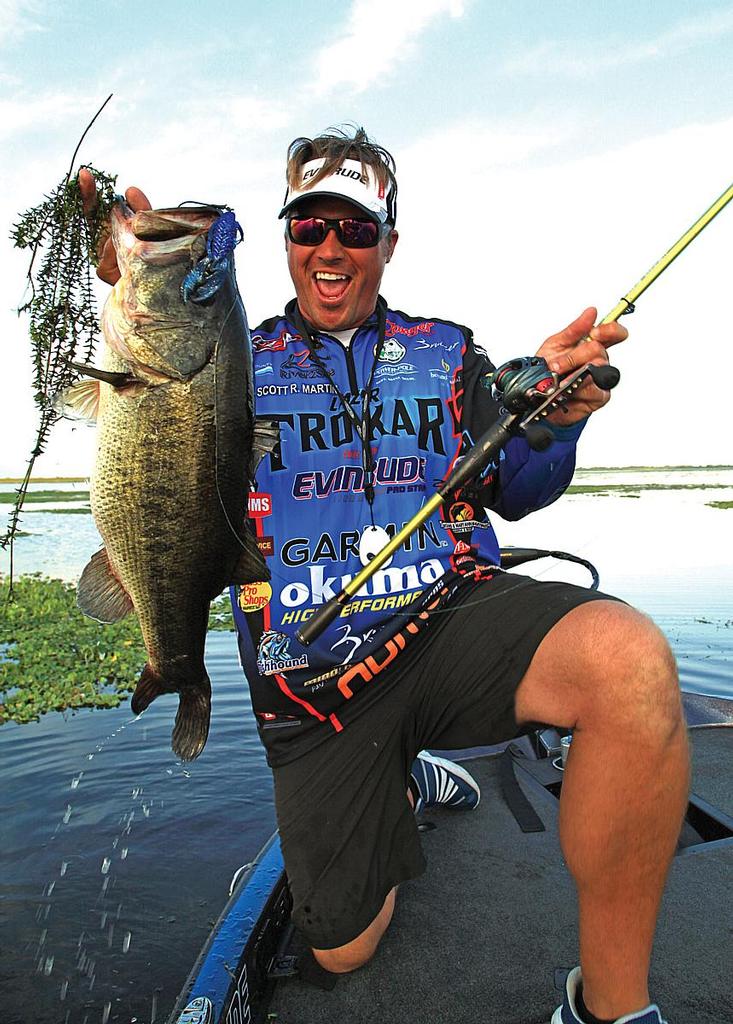
(Editor’s note: This article originally appeared in the 2014 February issue of Bass Fishing magazine. To read more compelling articles from Bass Fishing magazine each month, become an FLW subscriber member. If you’d like to sign up for a digital subscription to access articles online, click here).
A five-fish limit is the first measure of success and job one in a tournament. But it’s how you see that quintet shaping up that sets the tone for your performance. Is it an open audition where anything that measures will do, or do you want five stars that’ll rock any stage?
“For years, tournament anglers operated under the premise of, `Get a limit and then try to upgrade them with a big fish or two.’ But I think that the quality of the anglers and the quality of the fisheries are to the point that you don’t have the luxury of just fishing for a limit,” says Denny Brauer, who now resides on Texas big-bass powerhouse Lake Amistad. “I think you need to be fishing intentionally for big fish right at the get-go.
“During my career, I always fished to win,” he continues. “Right off the bat, I approached a lake from the standpoint of, `How can I go catch the biggest stringer I can catch?’ And if I don’t catch a limit – fine. I’m trying to be around the right quality of bass.”
We asked Brauer, along with fellow south Texas stick Tim Reneau, and Forrest Wood Cup champions Randall Tharp and Scott Martin – a pair of proven trophy bass anglers – for a glimpse inside their big-bass wheelhouse. Each shared thoughts that will benefit any big-bass seeker.
The quantity of quality
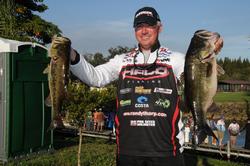 Other than the time of year, a typical tournament lake’s size and locale are the main determining factors in whether an angler should target a school or individual fish.
Other than the time of year, a typical tournament lake’s size and locale are the main determining factors in whether an angler should target a school or individual fish.
“Where I live, there are a lot of big fish, so encountering a school of 8- to 15-pounders can happen,” notes Brauer. “You go to some other fishery and you might be lucky to find two 6-pounders in one cove. The fishery really determines what the possibility is of getting into that school of giants. We all know the famous lakes – Guntersville, Falcon, Amistad – where those possibilities exist. When you go to a fishery like that you really need to try to find a school of those giants.”
Tharp says an angler should first find out what kind of weight it takes to win on a particular fishery at the time of year you’ll fish there. Divide that total by five, and you know the average quality of bass you need to catch – 3-pounder, 5-pounder, 7-pounder or whatever.
“Guys get complacent because they’re catching 100 fish a day, but sometimes the guy that wins the tournament might only get five bites,” Tharp says. “At the end of the day, you don’t know if I caught 100 fish, and it doesn’t matter anyway. All everybody gets to bring in is five, and the five biggest are going to win.”
Piscatorial perspective
Not everyone lives on a trophy bass fishery, but big bass behave the same no matter where they swim. According to Martin, prespawn staging sees consistent grouping of whopper bass in all bodies of water, relative to their numbers. Beyond that, the biggest bass live mostly solitary lifestyles, if not sparsely clustered by size.
“It’s a special day when you find a school of 7-pounders,” Martin says of most lakes. “That being said, fish will group by year-class. You know, fifth-graders don’t want to hang out with kindergartners.”
Whatever the big-fish spacing, Martin says finding the toads requires understanding their lifestyle.
“I’m watching my kids run around the yard, but if my grandmother was here she’d be sitting in a chair under a tree instead,” says Martin. “Older, big fish are sort of the same. They’re going to find that comfortable spot and just sit there. These fish are just not going to be roaming up and down the bank like the average-sized fish that anyone can find.”
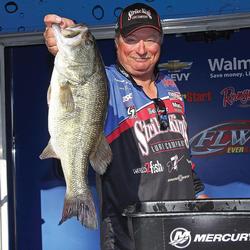 Brauer likens big-bass pursuits to hunting for big bucks. For one thing, the quarry feels more relaxed within a fortress of cover.
Brauer likens big-bass pursuits to hunting for big bucks. For one thing, the quarry feels more relaxed within a fortress of cover.
“Like big deer, big fish don’t like to be around the main stream of traffic – they want to be in the heaviest cover possible,” Brauer says. “If you really analyze any body of water and you look at the off-the-beaten-path areas, your odds go up of finding bigger fish that haven’t been bothered.”
Where heavy cover isn’t available, deep water offers the same protection to some degree. Another part of the equation involves dietary habits and the classic theory that big bass would prefer to spend less energy to eat a single large meal rather than spending a lot of energy to eat numerous small ones.
“Most of the places where you catch big fish don’t necessarily have lots of numbers,” Tharp says. “I think their lives and their feeding habits are totally different. You get around a bunch of 2-pounders and they’re not going to be able to eat the same thing that a 10-pounder eats. Whether it’s big crawdads or big bluegill or giant gizzard shad; those are all things that I’ve noticed have been around when I’m catching big fish.”
Sneaky in the search
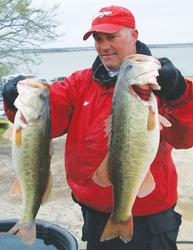 In most Southern reservoirs, Reneau expects the biggest bass to spend their summers and winters lounging close to some type of vertical structure on deep-water breaks “close to the ocean,” on isolated structure and contour subtleties.
In most Southern reservoirs, Reneau expects the biggest bass to spend their summers and winters lounging close to some type of vertical structure on deep-water breaks “close to the ocean,” on isolated structure and contour subtleties.
“As good as everyone is with their electronics and [digital] maps, the key is to go into places where the maps are not that good so you can find one of those little spots that’s not getting fished a lot,” Reneau says. “Every now and then a tournament is won on a community hole, but if you find something vertical that’s not on any of the charts, that’s a plus.”
Reneau points out that while most anglers will fish the corners, points or drains in a contour line, he likes to key on the really small stuff – what he calls “little notches.”
“Take Amistad, for example. [Several years ago] when it was just full of big ones, you could drive over them, see them on your electronics, drop a buoy on their head and catch them on 20 straight casts,” Reneau says. When they [major tournaments] started coming there and the lake started getting a lot of pressure, you’d drive over the fish, drop a buoy on them and you might catch two. Now, it’s gotten so tough that you can’t even drive over them. You have to stop short and make a long cast, and you might get two before the school scatters.”
Preparation
Gear selection is critical for targeting big bass. Stout hooks, heavy rods and heavy line are standard for most applications. Granted, you can catch a good one on your shaky-head rod, but if you’re planning to catch five trophies a day, you go fishing loaded for bear.
“I always say, `Don’t go to a gunfight with a knife,'” says Tharp. “I want to have the strongest, heaviest stuff I can possibly get away with. I want to be sure that if I get one to bite, I can get it out. There are a lot of guys who’d rather get more bites and lose half of them, but I’d rather get fewer bites and catch each one.”
Brauer’s also a big fan of beefy tackle, but on the flipside, he knows there is such a thing as “over gearing.”
“Sometimes people get a little carried away,” he says. “Eighty-pound braid in clear water, even if you’re pitching trees, might keep you from getting bites, whereas 25-pound fluorocarbon would have done the job just fine. It’s just a common-sense approach, but you need to set yourself up properly to catch big fish.”
Tharp adds that the guys who consistently win big-bass slugfests are the guys who live near big-bass waters. From experience, they understand how to target, hook and land trophy bass. If you can’t spend time on a trophy fishery to practice up before a tournament, at least make the most of the practice period.
“I catch ’em in practice,” Tharp says. “I want to know what I’m looking at. You can tell when a good one bites, but you can’t tell if it’s a 3-pounder or a 5-pounder without seeing it, so I definitely recommend catching some. I want to know how many bites I’m going to get and what time of day I need to be there.”
Home-run fish
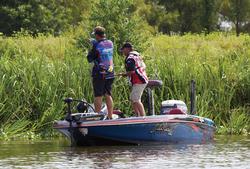 Can the big-bass strategy backfire? It happens all the time. But it’s safe to say that those who’ve gone to bat intentionally swinging for the fences are the ones who hit it out of the park more often.
Can the big-bass strategy backfire? It happens all the time. But it’s safe to say that those who’ve gone to bat intentionally swinging for the fences are the ones who hit it out of the park more often.
“Big fish are what win tournaments,” Martin says. “There are lots of ways to catch them, but in a tournament, I try to put myself in the best position to catch big fish, and that sometimes cuts down on your opportunities. I fish for those seven to 10 bites a day rather than 15 to 20 pounds a day. Proof is in the pudding when you look at the past history of some of the lakes we go to. It’s great to get checks, but winning is a hard thing to do. The only way you’re ever going to do it is by fishing to win.”
Best bets for big bass
What lures and rigs consistently produce big bass for this crew of hunters? We asked and they shared.
Denny Brauer
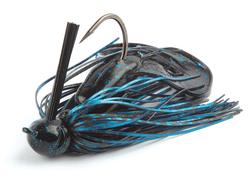 Reflecting on his career, Denny Brauer says that declining creel limits increased the value of catching quality fish over quantity. Analyzing tournament history told him that jigs produced the majority of big fish, so he committed to mastering what he considered a classic big-fish lure.
Reflecting on his career, Denny Brauer says that declining creel limits increased the value of catching quality fish over quantity. Analyzing tournament history told him that jigs produced the majority of big fish, so he committed to mastering what he considered a classic big-fish lure.
“I just thought if I could develop the techniques to get really good at jig-fishing, my odds of winning would go up,” Brauer says. “And if I started winning, I would have a great chance of surviving in the sport. That’s why the jig became my total focus, and I have no regrets.”
His jig of choice is one he designed: the Strike King Denny Brauer Premier Pro-Model Jig. He chooses green pumpkin or black-and-blue in 3/8- or 1/2-ounce size with a matching Strike King Rage Tail Rage Craw in warm water or a Strike King Rage Tail Rage Chunk in cold water.
Randall Tharp
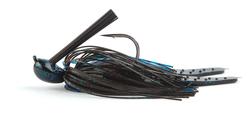 The reigning Forrest Wood Cup champ is a jig fan as well. His go-to is a 4×4 Randall Tharp Signature Series Jig in golden craw color or black-and-blue. He uses 3/8- to 1-ounce jigs with a Zoom Big Salty chunk trailer in green pumpkin, black-and-blue or sapphire blue.
The reigning Forrest Wood Cup champ is a jig fan as well. His go-to is a 4×4 Randall Tharp Signature Series Jig in golden craw color or black-and-blue. He uses 3/8- to 1-ounce jigs with a Zoom Big Salty chunk trailer in green pumpkin, black-and-blue or sapphire blue.
“A jig is a very versatile,” Tharp says. “It’s my go-to confidence bait, and it’ll catch them from Okeechobee to Champlain. No matter where I’m fishing, I’ve got one tied on. I’ve caught more big bass on a jig than any other bait, by far.”
Scott Martin
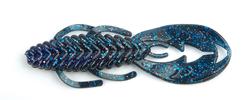 As a Florida bass expert, Scott martin knows how to pull big bass from thick grass. He does it with a Bruiser Baits Avenger (soft-plastic creature bait) in the knockout color, rigged on a 5/0 Lazer TroKar Flippin’ hook with a 1 1/2-ounce tungsten weight.
As a Florida bass expert, Scott martin knows how to pull big bass from thick grass. He does it with a Bruiser Baits Avenger (soft-plastic creature bait) in the knockout color, rigged on a 5/0 Lazer TroKar Flippin’ hook with a 1 1/2-ounce tungsten weight.
“Flipping the hyacinth mats is a big deal in Florida, and with that combination I have caught more giant bass in the last two years than I have in the last 10 years on any other bait,” Martin says. “I’ve caught bass up to 10 1/2 pounds, and hundreds of 7- to 9-pound fish.”
Tim Reneau
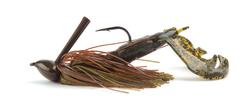 Tim Reneau is a grass-fishing expert and an experienced lure designer, but day in and day out, it’s still a simple jig that gets the call for big bass. He uses the new Strike King ¾-ounce Denny Brauer Structure Jig in green pumpkin or PG&J with a Strike King Rage Tail Rage Craw trailer.
Tim Reneau is a grass-fishing expert and an experienced lure designer, but day in and day out, it’s still a simple jig that gets the call for big bass. He uses the new Strike King ¾-ounce Denny Brauer Structure Jig in green pumpkin or PG&J with a Strike King Rage Tail Rage Craw trailer.
Reneau says he likes how the jig’s design melds two popular jig styles, along with a key feature that helps him capitalize on each big bite he coaxes.
“This jig is kind of a cross between a football jig and a casting jig,” he says. “Also, it has a zero-degree line tie; there’s no line sticking up to catch in a bass’ lip when you set the hook. It just slides through easily, and they’re hooked in the mouth 90 percent of the time.”